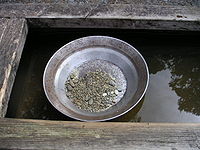
Gold panning
Encyclopedia

Placer mining
Placer mining is the mining of alluvial deposits for minerals. This may be done by open-pit or by various surface excavating equipment or tunneling equipment....
that extracts gold
Gold
Gold is a chemical element with the symbol Au and an atomic number of 79. Gold is a dense, soft, shiny, malleable and ductile metal. Pure gold has a bright yellow color and luster traditionally considered attractive, which it maintains without oxidizing in air or water. Chemically, gold is a...
from a placer deposit
Placer deposit
In geology, a placer deposit or placer is an accumulation of valuable minerals formed by gravity separation during sedimentary processes. The name is from the Spanish word placer, meaning "alluvial sand". Placer mining is an important source of gold, and was the main technique used in the early...
using a pan. The process is one of the simplest ways to extract gold, and is popular with geology enthusiasts because of its cheap cost and the relatively simple and easy process involved. It is the oldest method of mining gold. The first recorded instances of placer mining are from ancient Rome
Ancient Rome
Ancient Rome was a thriving civilization that grew on the Italian Peninsula as early as the 8th century BC. Located along the Mediterranean Sea and centered on the city of Rome, it expanded to one of the largest empires in the ancient world....
, where gold and other precious metals were extracted from streams and mountainsides using sluices and panning.
Process
Gold panning is a very simple process. Once a suitable placer deposit is located, some gravel from it is scooped into a pan, where it is then gently agitated in water and the gold sinks to the bottom of the pan. Materials with a low specific gravitySpecific gravity
Specific gravity is the ratio of the density of a substance to the density of a reference substance. Apparent specific gravity is the ratio of the weight of a volume of the substance to the weight of an equal volume of the reference substance. The reference substance is nearly always water for...
are allowed to spill out of the pan, whereas materials with a high specific gravity sink to the bottom of the sediment during agitation and remain within the pan for examination and collection by the gold panner. These dense materials usually consist primarily of a black, magnetite sand
Black sand
Black sand is sand that is black in color. One type of black sand is a heavy, glossy, partly magnetic mixture of usually fine sands, found as part of a placer deposit. Another type of black sand, found on beaches near a volcano, consists of tiny fragments of lava.While some beaches are...
with whatever gemstones or metal dust that may be found in the deposit that is used for source material.
Gold panning usually turns up only gold dust that is usually collected as a souvenir. Nuggets and considerable amounts of dust are occasionally found, but panning mining is not generally lucrative; panning for gold can be used to locate the larger parent veins of gold that most placer deposits originate from.
Pan
Pans are measured by their diameter in inches. Common sizes of gold pans today ranges between 10-17 inches, with 14 inches being the most used size. Pans are manufactured in both metal and high impact plastic. Heavy gauge steel pans are traditional. Steel pans are heavier and stronger than plastic pans. Some are made of lightweight alloys for structural stability. Plastic gold pans resist rust, acid and corrosion, and most are designed with moulded riffles along one side of the pan. Of the plastic gold pans, green and blue ones are usually preferred among prospectors, as both the gold and the black sand stands out in the bottom of the pan.In Mozambique, Africa local miners use pans made of wood.These pans are normally shaped like flat cones and have a slant angle of 15 to 25 degrees.Pan Designs
Gold pans of various designs have been developed over the years, the common features being a means for trapping the heavy materials during agitation, or for easily removing them at the end of the process. Some are intended for use with mercuryMercury (element)
Mercury is a chemical element with the symbol Hg and atomic number 80. It is also known as quicksilver or hydrargyrum...
, include screens, sharp corners for breaking ice, are non-round, or are even designed for use "with or without water".
Edward Otho Cresap Ord, II
Edward Otho Cresap Ord, II
Edward Otho Cresap Ord, II was a United States Army Major who served with the 22nd Infantry Regiment during the Indian Wars, the Spanish–American War and the Philippine-American War....
, a former Army officer and co-owner of several mines, patented several pan designs including designs for use with mercury or dry.
See also
- C. J. StevensC. J. StevensClysle Julius Stevens is a writer. He has published over 30 books , been published in hundreds of magazines, and the United States Library of Congress contains a special collection of his works.In 1998, the Portland Press Herald described him as "versatile and...
, author of The Next Bend in the River: Gold Mining in Maine and Memoirs of a Maine Gold Hunter

